
Wound Dressings Page Menu: 1 2 3 4 5 6 7 8 9 10 11 Next>>
Wound Dressings in the Golden Age of Piracy, Page 2
"The Operation ended, we are to dry up all the Blood very clean, washing the Shoulder with warm Wine, and lay on the two Plaisters on the two Places where we have made the Scarifications [a series of small incisions designed to let blood from a body part]. They [the plasters] are of burnt Ceruse, because nothing is now to be done but dry them up; they are to be renewed some Days after, which is to be done till the Patient is perfectly cured." -Pierre Dionis, A course of chirurgical operations: demonstrated in the royal garden at Paris, 2nd ed., p. 475
Plasters: Their Forms
"The Shape or Figure of Plaisters is so much varied, that 'tis impossible to mention all of them"1. Nevertheless, Pierre Dionis makes an attempt at mentioning the ones he considers important. He explains that all plasters are "divided into small, middling and large, accommodated to the figure and size of the Part on which they are to be laid."2 He further classes them as being universal, or "proper for all Parts of the Body"3 , 'particular' - "which are adapted to several Parts, and not to the whole"4 and 'peculiar' - "because they are solely applicable to a particular Part"5. His diagram and descriptions are rather interesting and eminently readable, so I'm going to insert them here verbatim.
"The first, A, is Circular, the commonest and most frequently used.
The second, B, is Quadrangular, of which Shape there are both large and small.
The third, C, is Oval, that is, of a curve Figure, longer than it is broad: 'Tis applied to several Wounds, which are longer than broad, and 'tis knotch'd by the Scissars, in order to accommodate it the better to be laid on over the Plegets.
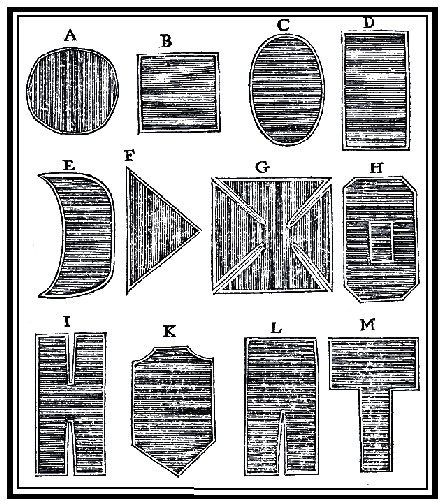
Of Plasters, A course of chirurgical operations, by Pierre Dionis,
Table 5,p. 27 (1733)
The fourth, D, is Oblong, 'tis cut in this Shape when intended to wrap round an Arm or Leg in a Fracture: Several lesser of the same Figure are prepared to wrap round a Finger.
The fifth, E, shap'd like a Crescent or Half-Moon, is proper for a Fistula in the Anus, when 'tis on one side: Very small Plaisters of this shape are also apply'd to the Eye-brows.
The sixth, F, is a Triangular Plaister, so shap'd to fit it to the Indenture of the Groin in the Bubonocele. Triangular Plaisters are also used in the Fistula Lachrymalis, or Fistula of the Eye, but are cut much smaller.
The seventh, G, is cut like the Cross of Malta, and is very proper to be apply'd to the remaining Extremity of an amputated Member; the same Shape is also given to a little Plaister apply'd after the Amputation of a Finger.
The eighth, H, is the Window Plaister, so called on account of its Hole in the middle: Its use is for Fractures with a Wound; and the convenience of this Aperture is, that the Wound may be dress'd without taking off the Plaister all round it. 'Tis also useful in Bronchotomics [surgery on the throat].
The ninth, I, is the Trapezian Plaister, knotch'd or cut at the two ends, to render it proper for unequal Members.
The tenth, K, is called the Escutcheon Plaister, because shap'd like one: 'Tis a large Plaister cut in this Form, when the Intention is the Application of Vesicatories [blister plasters] betwixt the Shoulder.
The eleventh, L, is term'd the Hypsiloide Plaister, because shap'd like the Greek Y: 'Tis apply'd to the Perinætum [genitals and anus] after Lithomy [Lithotomy - cutting a stone out of the kidney via the anus].
The twelfth, M, is call'd a T, by reason of its resembling that Letter: 'Tis apply'd to Incisions of that Figure. There are several other Plaisters which I don't mention here, because it frequently depends on the Chirurgeon to shape them conform to the Part, or Malady, for which they are used."6
1 Pierre Dionis, A course of chirurgical operations: demonstrated in the royal garden at Paris. 2nd ed., p. 26; 2,3,4,5 Dionis, ibid; 6 Dionis, p. 26-7
Plaster Use: Blister Plasters
Blister plasters were designed to raise blisters on the skin.
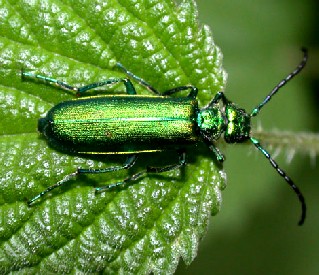
Photo: Franco Christophe
A Spanish Fly (actually a beetle)
They were typically made with powdered mustard or cantharides (Spanish fly's wings) combined with other elements. Cantharides are mentioned more frequently than mustard in the various surgical manual from the golden age of piracy, so one might surmise that they were preferred. In preparing them, sea surgeon Jack Handley noted that "if the Heads and Wings of the Flies were first thrown away, it would be the better."1
Blistering was done in the name of humoral theory; the fluids raised in the blisters were believed to be bad humors leaving the body. It was thought that the body contained many fluid humors upon which health depended; illness was a sign that the bad humors were overpowering the good ones. Thus, the bringing forth of blisters was thought to force the bad humors out, cleansing the body and allowing it to heal.
Jack Handley gives us some detail on how this worked. A blister plaster was applied to a body part where the heat of the body "so provoked [the blistering agent] to exert their poisonous Energy, [that they] abundantly dispatch out fiery Particles, which penetrate the Cuticula [technically this means 'cuticle', but he seems to be referring to the outer skin] without an Laceration; they are thrown upon the Skin, where they first act upon the Spirits, and then upon the Humours and solid Parts; they dissolve the Humours, excite painful Convulsions of the Fibres; and the Humours being dissolved, are constrained to separate into Parts; and its watry Part, which is tainted by the venomous Particles of the Cantharides, is rejected by the other Juice, and spewed out between the Cutis and the Cuticula, and so raises a Blister."2
Blister plasters were used in many different illnesses. Pierre Dionis advises a surgeon to apply "Vesacatories [blister plasters] to the Shoulders for the Apoplexy and Epilepsy, or to the Thigh for the Gout, [where] he must allow enough to raise a great Number of Blisters, and draw out a greater quantity of the serous Humour."3 Handley advised blistering in "all cutaneous Distempers, also in malignant Fevers, Head-Ach, Vertigo, Sopor [sleepiness], in Defluxions [fluid discharges] of the Eyes, Nose, Palate, or Lungs, Convulsions, Epilepsy, Apoplexy [unconsciousness], Lethargy, &c."4 Handley also details diseases where they should not be used, which included illnesses "that are subject to the [kidney] Stone, Gravel, or Stranguary [painful, frequent urination]"5.
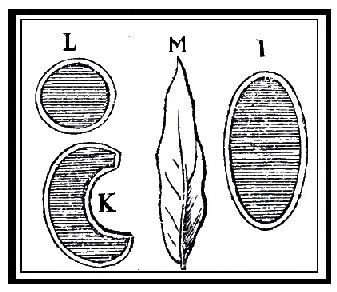
For Leaches and Vesicatories, A course of chirurgical
operations, by Pierre Dionis, Table 58, p. 475 (1733)
When applying a blister plaster, Dionis advises the surgeon "gently to rub the Part, that the Vesicatory may have the more expeditious Effect: He is to leave it on four or five Hours, and sometimes longer, according to the tenderness and disposition of the Patient. When the Epidermis is risen in Blisters, the Pain ceases to be so great, and the Blisters being full of serous Humour, he is to open them to let it out: He also causes it to run out for some Days, by laying on the Pear-tree Leaf M [see image below left]; and the more he causes to run out, the more the Patient is eased, and delivered from the pressing Danger; which is the end proposed in this Operation. When they have run enough for two or
three Days, he applies Desiccatives [drying medicines] to heal them. ... When we would not raise so many Blisters, we spread the Composition on a little bit of Linen or Taffeta, when 'tis to be put behind the Ears, and on the Temples"6.
He further explains that "Blistering is an excellent Remedy against the Bitings of venomous Beasts, and against the Gout: We cover with this Composition the bit of Linen I, which we lay on the bitten place. They are also excellent in Defluxions on the Ears and Eyes: When we spread on the Plaister K, shap’d like a Crescent, and lay it on behind the Ear; and we are relieved in the Tooth-ache, by laying the small round Plaister L on the temporal Artery."7 The purpose in these and other cases was still to get at those bad humors. Dionis suggests that the surgeon apply blister plasters "to the Shoulders for the Apoplexy and Epilepsy, or to the Thigh for the Gout, [where he] he must allow enough to raise a great Number of Blisters, and draw out a greater quantity of the serous Humour."8
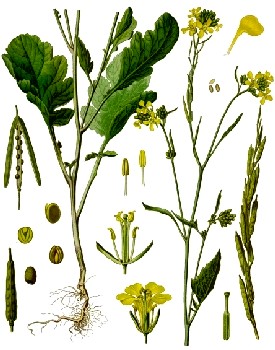
Artist: Franz Eugen Koehler
Mustard Plant - Brassica Nigra (1897)
Sea surgeon Thomas Aubrey gives us a detailed account of using a blister plaster to help heal Carpenter’s Mate Joseph Skibb of the Peterborough, who "perceived at first suddenly a very sensible Coldness all over his Body, and also a Soreness, as if he had been beaten; his Senses in a manner went from him, so that he had a kind of Feebleness, or Dejection of Spirits; after which he became very hot, had a prodigious Pain in his Head, Vomiting, &c."9
Illnesses like this, often referred to generically as 'fevers' were thought to be prime examples of the humors being out of balance. Aubrey immediately had Skibb bled and prescribed an emetic which he noted "operated copiously"10, so much so that he prescribed something to counter it. Bleeding and purging were common ways to chase out the bad humors.
The next day, Skibb became delirious, so Aubrey "ordered a large Blister Plaister betwixt his Shoulders, on the Nape of the Neck; and double Compresses... to be applied to his Forehead, and all round his Temples. The Blister rose very well, which was a good Sign, and run very much, and did him a great deal of Service, although he continued a little delirious, between whiles, till the seventh Day about four in the Afternoon, although not so very much as before the Application of the Blister and Compresses; which said Compresses were continued till those Symptoms quitted him."11Military surgeon Richard Wiseman tells of applying one after he had cured a patient of burns and rat bites, clearly with an eye toward balancing the humors.. As he explains, "I made him a Fontanel in that Arm [that was burned], and bathed the member frequently, also cupped and scarified it; and afterwards applied Plaisters of Pitch, to stir up a heat in the Members."12 Wiseman wasn't taking any chances with the humors in this case - the only humor-balancing remedy he appears to have left out was direct bleeding of the patient.
1 Jack Handley, Colloquia Chirurgica: or The Art of Surgery, p. 167; 2 Handley, p. 165-6; 3 Pierre Dionis, A course of chirurgical operations: demonstrated in the royal garden at Paris. 2nd ed., p. 477; 4,5 Handley, p. 166; 6 Dionis, p. 477-8;7 Dionis, p. 477; 8 Ibid; 9 Thomas Aubrey, The Sea-Surgeon or the Guinea Man’s Vadé Mecum, p. 33; 10 Aubrey,p. 34; 11 Aubrey,p. 34-5; 12 Richard Wiseman, Of Wounds, Severall Chirurgicall Treatises, p. 438
Plaster Use: Sticking Plasters
Sticking plasters were the forerunners of what we think of today as the Band-Aid. A sticking plaster consisted of a fabric, often silk, which was spread with an adhesive to make it stick to the skin around a wound. An adhesive commonly used around the golden age of the pirates was isenglass - "a substance obtained from the dried swim bladders of fish (during this time - sturgeon)"1. German surgeon Matthias Gottfried Purmann recommends that in generic wounds, the lips of the wound be drawn together by a sticking plaster which the surgeon is to "continue on five or six days, and you will have no occasion for above four or five of them, before the wound is perfectly cured."2
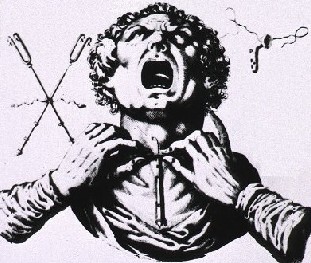
Laryngotomia with bent pipe (upper right) from De vocis
auditusque organi historia anatomica singulari fide
methodo,
by Josia Murer, Table 22, p. 122 (1601)
Purmann also suggests using sticking plasters when performing a Laryngotomia (Laryngectomy - the cutting open of the Aspera Arteria or windpipe). He advises that once the surgery is complete, the surgeon should "place a crooked Pipe in the Opening, that the Breath may have free Passage out and in, as long as it is requisite... The further part of the Pipe must have a short of a round Brim, about which you may pull the Skin round, and fasten it with a good sticking-Plaister. When the Inflammation and Swelling is quite gone, pull out the Pipe, and draw the Skin and Muscles better together, and so heal it up."3
In fairness, it should be noted that a this operation was delicate and not very common. Because of its delicacy, it was probably not done shipboard due to the lighting and movement of the ship.
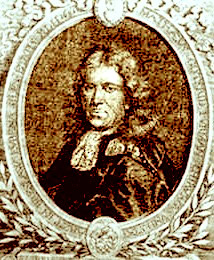
Matthias Gottfried Purmann
Another example of using sticking plasters was for a more regularly performed shipboard operation: amputation. In his procedure for amputations, Purmann suggests that the surgeon "draw the Skin over the Stump and pull it together with good sticking Plaisters, or four good Stitches."4 The sticking plaster was here used to keep the skin closed so that it could heal over the stump.
You may have noticed that our direct references to sticking plaster have so far come from German surgeon Purmann. Some of the other period surgical authors suggest using a plaster on the stump at this point. For example, Pierre Dionis recommends "to take in the whole Stump, and cover'd with Astringents; a Bladder, at the bottom of which are Astringent Powders, and which is cleft to slip the Stump into it, a large Plaister and Bolster cut like a Maltese Cross"5, which he has drawn in his Table 5, cited previously. Although he doesn't specify that this be a sticking plaster, Purmann's use of a plaster suggests that it would be.

Dionis, p. 466
Pierre Dionis advises the use of a sticking plaster in cauterization, to help prevent the cauterizing agent from burning the skin surrounding the targeted spot. "We begin with cutting the little round Plaister G, of the size of a Crown-piece, and provided with a Hole in the middle; we cover it with a very emplastic Unguent, that it may stick fast to the Skin, and hinder the Scar becoming larger than the Hole in the middle of the mention'd Plaister, which is to be proportioned to the Dimensions of the Cautery which we design to lay on. We lay this Plaister on the Place defin'd to the Cautery, taking care that it be well placed."6
1 Isinglass,wikipedia, gathered 9/11/12; 2 Matthias Gottfried Purmann, Chirurgia Curiosa, p. 181; 3 Purmann, p.46; 4 Purmann, p. 210; 5 Pierre Dionis, A course of chirurgical operations: demonstrated in the royal garden at Paris. 2nd ed., p. 410; 6 Dionis, p. 468
Plaster Use: Mollifying Plasters
Two authors recommend 'Mollifying' plasters after cauterization [burning of the vessels with hot irons to stop them from bleeding] to help relieve the pain.
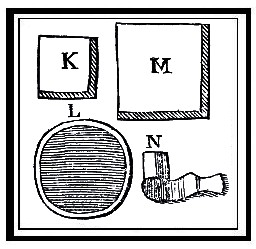
For Cauteries, A course of chirurgical operations,
by Pierre Dionis, Table 56,p. 466 (1733)
Matthias Gottfried Purmann recommends that when cauterization "has been regularly performed, apply to the yellow spot some bruised Garlick and Drachylon [Emplastrum Plumbi—a plaster made of lead oxide boiled together with olive oil and water], or some other Mollifying Plaister over it, and let it continue on eight or nine hours; then take it off and cut the Blister if there is one, if not, lay the rough side of a Plantan [Plantain] Leaf to the burn'd place to keep the Wound open, for the smooth side I know by experience will heal it."1
Pierre Dionis uses it as well in his rather complex listing of wound dressings used following a successful cauterization. After the cauterization is complete, "we lay [upon it] the little Bolster K, shap'd square, and wetted for the same end, this we cover with the large Plaister L, and afterwards with the Bolster M, and over that fix a circular Bandage with the Band N, which we draw somewhat tight, that it may rest on the caustic Stone, and hinder the Apparatus from shifting its Place."2
1 Matthias Gottfried Purmann, Chirurgia Curiosa, p. 307; 2 Pierre Dionis, A course of chirurgical operations: demonstrated in the royal garden at Paris. 2nd ed., p. 469

